Concrete floor grinding technology
The grinding of concrete floors is carried out in order to obtain an impeccable smooth surface and to improve technical, aesthetic, operational characteristics. It can be an independent repair stage or a preparatory process before applying a bulk floor. Grinding the concrete floor in accordance with the technological building requirements guarantees a long service life, eliminates the need for frequent repairs, and ensures favorable hygienic conditions.
Content
- Concrete Floor Priorities
- The goals and objectives of grinding
- And if you do not process?
Concrete Floor Priorities
Universal concrete floors are arranged in rooms with different sizes. They are used to equip ceilings adjacent to basements in low-rise construction. Concrete floors are the best option for commercial premises with active traffic and for areas where equipment is moving intensively. Polished durable concrete floor:
- perfectly harmonizes with almost any interior;
- maintainable and does not require significant operating costs;
- It is characterized by safety according to environmental criteria;
- resists aggressive chemical and fat-containing compounds;
- shows resistance to constant loads of dynamic and static nature.
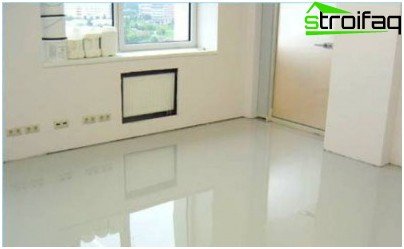
Polished concrete floors are in perfect harmony with any interior composition.
The goals and objectives of grinding
The final result of the decoration of the room depends on the quality of the grinding work.
The essence of grinding is to eliminate the upper weakened layer, which is unable to hold the load firmly, and which does not differ in decorative appeal. Grinding work is performed by:
- at new concrete flooring to remove the upper brittle layer containing weak finely dispersed aggregate particles, to eliminate bumps, tubercles and other surface defects;
- in preparation for polishing or applying a floor covering that requires ideal geometric parameters of the base;
- during the preparatory work for the installation of bulk floors with the aim of forming a roughness that increases the adhesion force;
- in the formation of favorable conditions for operation, during which the upper part spreading the harmful dusty suspension is removed;
- when restoring the technical characteristics of a worn concrete floor, for which they simply remove the destroyed top layer.
And if you do not process?
Untreated and not repaired concrete floor loses its main advantage – strength. Moreover, the loss of strength occurs not only due to crumbling of areas with defects, but also because of the ability of unpolished concrete to absorb moisture. At negative temperatures, water crystallizes and increases in volume, destroying the structural bonds in the material. This fact negatively affects the floors arranged in the ground floors of private, commercial, public buildings and in open areas..
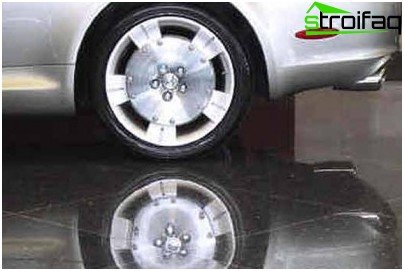
The concrete floor is polished to improve performance: the polished floor holds the load better, does not absorb moisture
Concrete screed followed by grinding
Strengthening of the new concrete floor occurs during its initial curing during the first seven days from the time of screed pouring. It takes 28 days for concrete to gain basic strength. A further final increase in density, therefore, and strength occurs in the process of many years of operation. It is recommended to grind the concrete floor during the second or third week, calculated from the moment of pouring the screed.
It is important to note that grinding does not imply adjusting the horizontal direction of the floor. Observe the correct geometric direction of the plane when pouring concrete.
Power and material
The thickness of the screed layer for grinding by building standards is 3 cm, but more powerful options are possible. It is permissible to have protruding tubercles and pits, the difference in difference between which does not exceed 5 mm.
The reference point for the choice of material for concrete screed is the purpose of the object. For monolithic concrete floor in the garage, in the production workshop, in a small warehouse, as well as for the installation of platforms or paths on the street, concrete is used with markings ranging from M150 to M300. This material is reliable enough for operation and has priority qualities for further grinding. If higher requirements are imposed on the floor according to strength criteria, material with a marking greater than M300 is taken for screed.
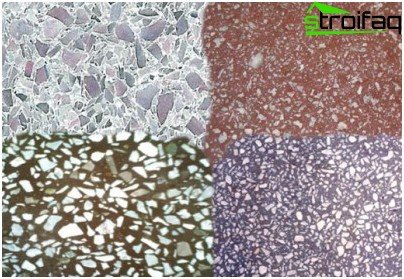
Concrete aggregate determines the technical characteristics and decorative characteristics of the concrete floor
The optimal aggregate of concrete screed for grinding is crushed stone of small fractions of metamorphic and igneous rocks. If a subsequent polishing is planned and the decorative component is important, then the use of fine crushed granite or marble chips will help create an original surface with a stunning effect.
It is best to process material with marble chips, granite and sedimentary gravel are poorly polished. Excessive density of the filler is not desirable for grinding work, and low performance can reduce the characteristics of the floor as a whole. Therefore, in the arrangement of the lower floors, slag aggregate is not used at all.
Standard grinding steps
The technology for processing and finishing concrete floors depends on the conditions of subsequent operation. Stages of full-fledged work can be from 3x to 15ti. The volume of the complete processing cycle is affected by the appearance requirements, the type of room and the condition of the floor (repair or installation of the floor during the construction period).
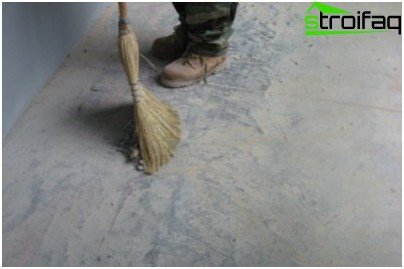
Thorough preparation and cleaning of construction debris and dust is an important stage that precedes successful sanding.
Regardless of the number of planned events, there are standards that are implemented in most cases, these are:
- Preparatory work. Cleaning the concrete surface, dismantling carpets, epoxy floors, tiles. Dismantling of a worn bulk coating or the top layer of a concrete floor is carried out using milling machines. In the process of preparing the floor plane for further processing, repair and restoration work is carried out, crumbled areas, expansion joints, cracks, and potholes are closed. All sludge, dust and debris are removed..
- Pouring a concrete screed with preliminary application of a composition that improves adhesion parameters, the implementation of which is necessary when removing a large layer of cement floor during repair work.
- Directly grinding the concrete floor, which includes several stages, the number of which depends on the goals set by the builders and the expected result. Each of the stages determines the use of abrasives with different grain sizes, as well as optimizing the result and wear resistance of the impregnation material. Processing of concrete coatings is carried out to the stage of maximum exposure of filler grains. In this case, the floor must achieve strength, excluding the separation and crumbling of finely dispersed aggregate and large inclusions. The maximum exposure of the grains of material when removing 5-7 millimeters.
- Compaction of the concrete floor with the help of special impregnations and flues, due to which the concrete perfectly resists powerful intense mechanical stresses. Impregnation solutions are applied until the concrete stops absorbing them..
- Polishing as the final stage is carried out if it was not intended to be laid on a polished floor made of concrete flooring. It is carried out using thinner abrasives in comparison with abrasives used in grinding. The number of stages of polishing depends on the requirements for decorative indicators of the floor.
At the end of the machining, baseboards are installed in the area of abutment of the lower floor and walls, surface treatment is carried out. To give the surface a glossy effect, polyurethane varnishes are used. The varnish is applied with the help of rollers and brushes immediately after sanding to a dust-cleaned surface. Most often, the floor is varnished in several layers..
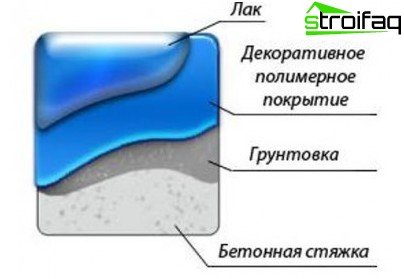
The sequence of arrangement of the layers when pouring the bulk floor on top of the polished concrete base
A clear horizontal position or the presence of a slope of the concrete floor is checked by a control device, which is a template rail with a level. The degree of adhesion of the concrete screed to the underlying layer is checked by tapping the entire site. If, as a result of tapping, a site with a lack of adhesion was detected, the floor will have to be shifted. According to building codes, no seams are allowed in the massif of the concrete floor, cracks between the skirting boards and the coating plane.
Compliance with technological requirements when grinding a concrete floor will provide wear resistance, excellent decorative coatings, ease of movement and excellent conditions for use. Perfectly sanded floor is not easy to maintain, does not require frequent repairs, which confirms the cost-effectiveness of a rather cheap but beautiful concrete floor.






